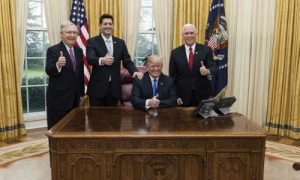The new Tax Cuts and Jobs Act sets off several important changes in healthcare to watch in 2018.
Millions of Americans will choose to opt out of the individual mandate, which was eliminated. An estimated 4 million will make that decision in 2019, and by 2027 13 million will lack healthcare, according to estimates from the Congressional Budget Office (CBO).
Some other expected changes: Fewer people will sign up for Medicaid, government health-insurance subsidies will drop and insurance premiums will increase 10% a year for those who don’t belong to a group.
Business reporters can look into one or more of the following angles as the most significant tax-code changes since 1986 play out in the healthcare marketplace.
Explain the impact of rising healthcare costs on your readers
Even though employers pay for most of their employees’ healthcare costs (from 67% to 71%, according to the U.S. Bureau of Labor Statistics), U.S. families are spending a growing percentage of their incomes on healthcare. In 2015, according to the Commonwealth Foundation, families spent an average of 10.1%, or $6,422, annually on health insurance premiums and deductibles, but in some states (Arizona, Florida, Mississippi, New Mexico, Oklahoma, Tennessee, and Texas), that number eats up 12% and more.
What are your readers spending on healthcare, and how are they managing as costs increase? Commonwealth offers a state-by-state breakdown. You can also find information from your county and state health departments.
Look at local business leaders driving change
Are any business leaders in your community considering a “health alliance” like the one recently announced by Jeff Bezos of Amazon, Warren Buffet of Berkshire Hathaway and Jamie Dimon of JP Morgan Chase? They want to leverage their collective strength to drive down costs and shift the paradigm on employee healthcare.
The idea isn’t a new one: Check on the progress of the “Health Transformation Network,” launched in 2016. Are any local businesses already offering improved food choices, internal mentoring programs, child care and elder care, and counseling and other programs? What progress do they report?
Focus on how the individual mandate affects your readers
Use your news organization’s social media channels and then hit the street to ask readers if they plan to buy healthcare this year or opt out of the individual mandate. Identify a range of readers who represent your readership: millennials, Baby Boomers, single, and married, and those at different income levels. How do they plan to pay for healthcare?
Have a local financial planner or consumer advocate offer smart ways to bulletproof such a decision. Do they have emergency savings to pay for a medical bill, if they choose to opt out? Call your state and county health departments and ask how the tax cuts law affects their ability to help residents who need health coverage, or use this link to find more information.











